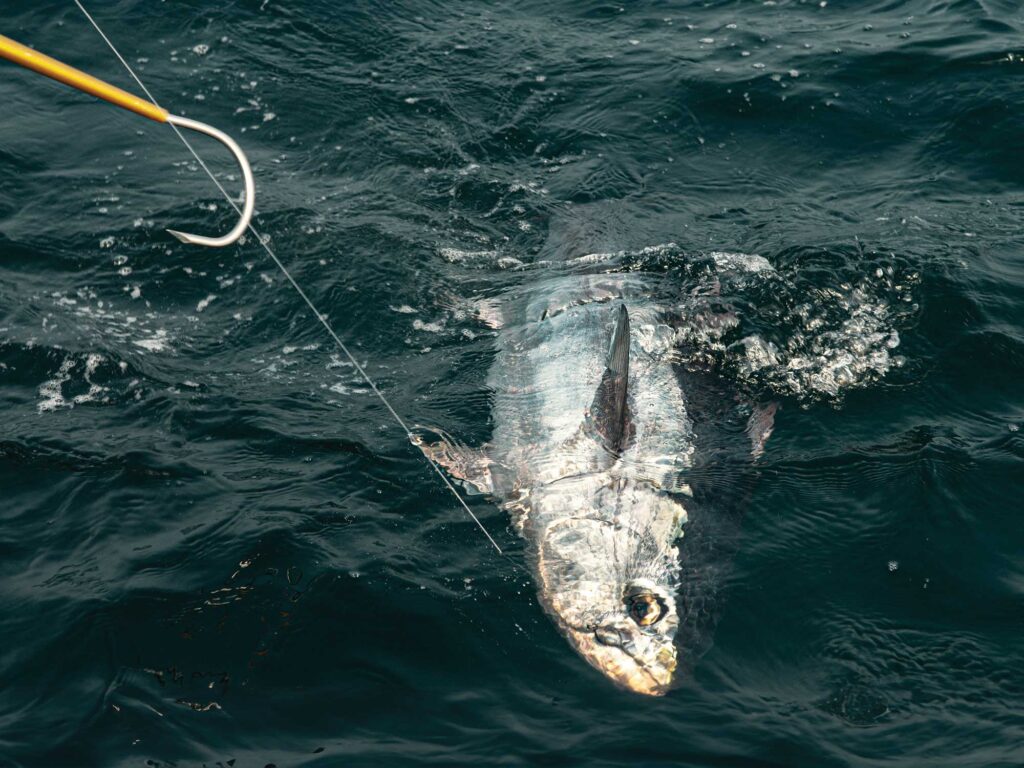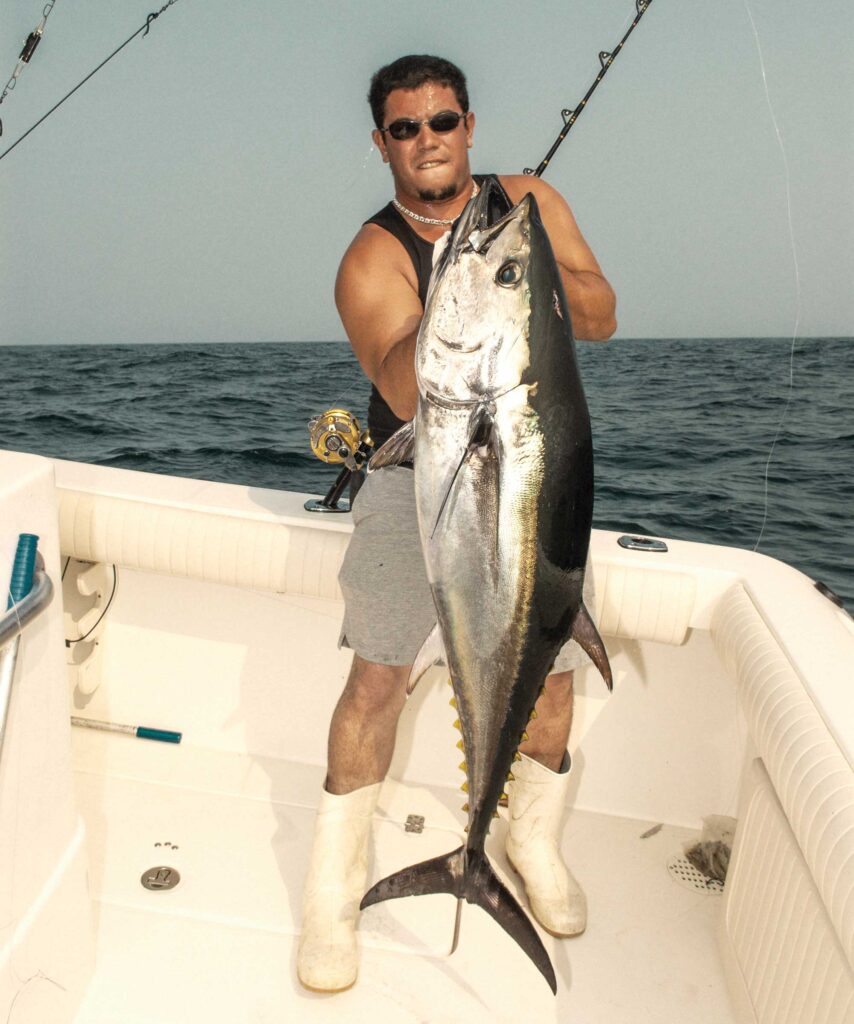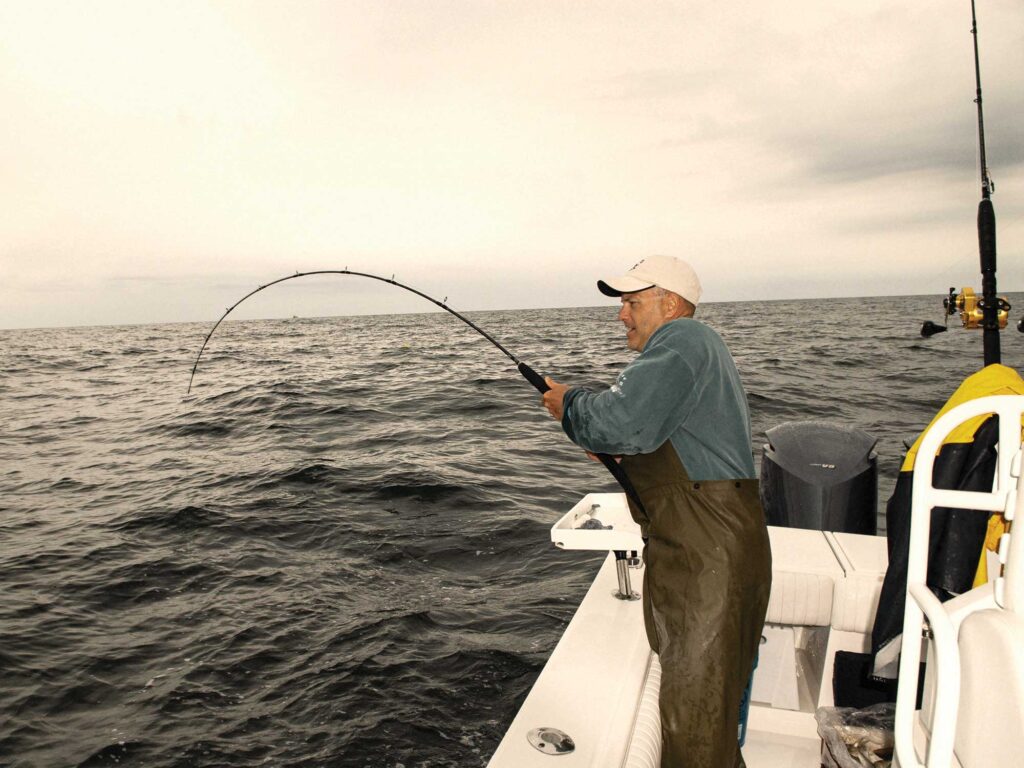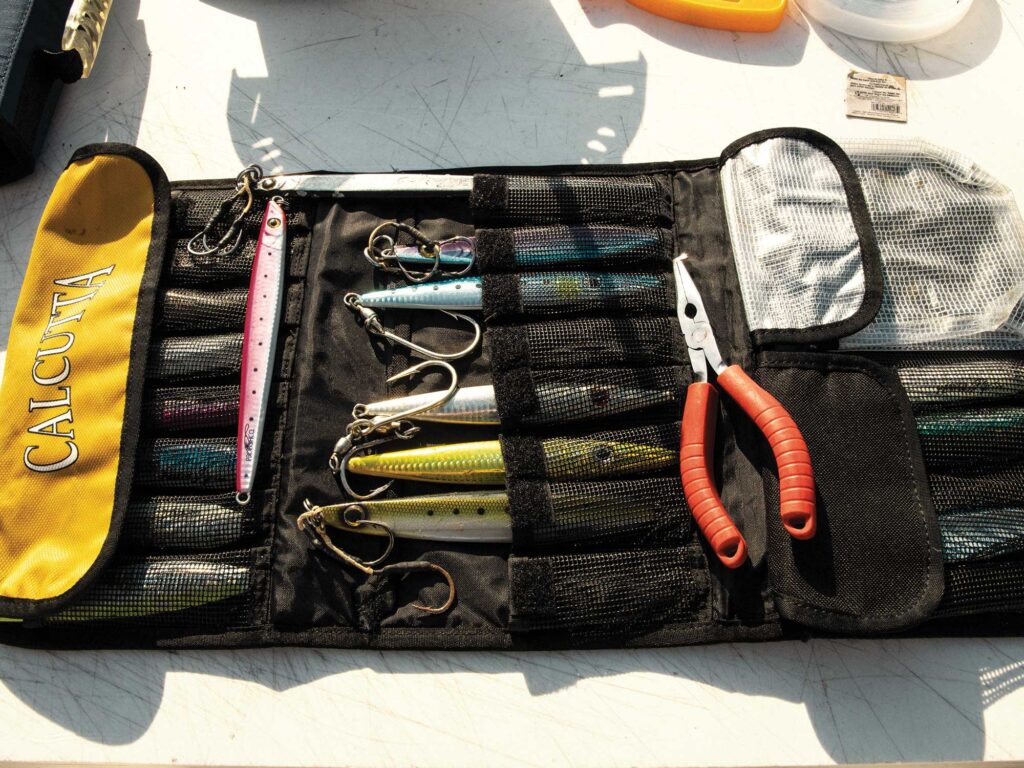SB Television
Targeting Nearshore Tuna in the Northeast
 Large and school-size bluefins returned to the inshore waters off New Jersey, offering short boat runs and memorable fish fights.
Gary Caputi
Large and school-size bluefins returned to the inshore waters off New Jersey, offering short boat runs and memorable fish fights.
Gary Caputi
The call came late in the afternoon of September 8 two years ago. A friend told me there were bluefin tuna on some nondescript sand lumps just 8 miles off Asbury Park. Say no more. I assembled my tackle—jigging sticks, spinners for poppers, stand-up rods for live bait—and loaded them in my pickup. The next morning, we were at the boat at first light with a goal for my wife, Ginger, to catch her first tuna.
On our way around the tip of Sandy Hook, I stopped under diving birds and began casting a sabiki rig. We were rewarded with a few snapper, bluefish and four herring for the livewell. We continued on to the lumps, a couple of miles west of the Mudhole within sight of buildings on the beach. As we neared the structure, the depth finder lit up with baitfish and tuna marks.
We put out two live baits, and the first herring was inhaled before our drift even developed. Ginger fought the tuna to boatside, but it came unbuttoned just out of reach. The second run-off, a larger fish, came on a 30-pound outfit. I was on the rod while Ginger ran the boat masterfully for the next 75 minutes. I did laps around our 2700 Open Pathfinder, up and down the bow casting deck, around the console to the transom, and back up the other side at least a dozen times before the fish was finally gaffed—100 pounds, nice.
Back at the lumps, Ginger dropped a jig, and the line came tight on the first lift off the bottom. This one was a handful, refusing to come shallow until the very end as Ginger pumped it up through 80 feet of water, spiraling the whole way. With both angler and fish exhausted, we tried for a while longer, with plenty of fish still showing on the depth finder. But the bite had waned, so we headed back to the marina and the cleaning table. Toro was on the menu.
If you think this sounds like a rare occurrence, you’re wrong. Bluefin tuna from 30 to 300 pounds have been coming very close to shore the past few years along the Northeast coastline and staying there for quite some time. The fishing last summer and fall was epic. No need for a big boat and long runs offshore, just some intel and the right tackle. But why is this happening?
 Summer in the Northeast means warm weather, cool ocean breezes and, increasingly, bluefin tuna close to shore. This is a bonanza for the small boater because the short runs are accomplished easily in the smaller vessels typical of the Striper Coast.
Gary Caputi
Everything Old Is New Again
Summer in the Northeast means warm weather, cool ocean breezes and, increasingly, bluefin tuna close to shore. This is a bonanza for the small boater because the short runs are accomplished easily in the smaller vessels typical of the Striper Coast.
Gary Caputi
Everything Old Is New Again
The go-to guy for bluefin information is Ray Bogan, a Point Pleasant attorney and captain with 100 years of family history in the party- and charter-boat business. He just finished a long run as the US recreational commissioner to the International Convention for the Conservation of Atlantic Tunas, which sets quotas for tuna, sharks and billfish oceanwide. Bogan has fought for fair allocations for US anglers throughout his tenure, and without him there might be no recreational bluefin fishery at all. In fact, his hard work to refute an ill-conceived stock assessment by NOAA recently paid off in a slight increase in bag limits for the angling category the past couple of years instead a significant reduction.
“My family has records and recollections from the 1920s, 1930s and 1940s of large schools of small to medium-size bluefin on nearshore spots like the Farms, the Klondike and farther north into the New York Bight,” Bogan says. “Historically, giants would come so close to shore, they would get caught inside pound nets, so what we are seeing now is a resurgence of a fishery that once existed.”
Bogan explained that from a regulatory standpoint, bluefin stocks in the Western Atlantic are not experiencing overfishing nor are they classified as overfished. “From my point of view, the stocks are expanding rapidly into a robust fishery for boats that can’t make the run to the canyons for bigeye and yellowfin,” he says. “I’ve always considered bluefin to be the blue-collar big-game fish.”
The widespread availability of menhaden, sand eels and, this past year, Loligo squid on nearshore structure attracts and keeps bluefins close to the beach throughout the summer and fall. The fish Ginger and I caught were on sand eels that took up residence on those lumps. A few weeks later, while fishing for striped bass, we saw 100-plus-pound bluefins crashing menhaden schools around our boat, almost within casting distance of shore. It’s obvious that water depth means little to these fish intent on going wherever bait is found.
 If you are lucky enough to tie into an inshore bluefin, be ready for a battle. These fish will test your tackle—and your back—way beyond what any striped bass or bluefish is capable of. Make sure your tackle is up to snuff and remember to bend from the knees.
Gary Caputi
Giants Among Us
If you are lucky enough to tie into an inshore bluefin, be ready for a battle. These fish will test your tackle—and your back—way beyond what any striped bass or bluefish is capable of. Make sure your tackle is up to snuff and remember to bend from the knees.
Gary Caputi
Giants Among Us
The developing inshore fishery isn’t just small and medium-size bluefins; there have been consistent showings of giants—fish over 73 inches—gorging on the abundant menhaden population. The last few years, anglers in all types of boats have been trying their luck at catching these massive fish, and many have succeeded. The area near the terminus of Ambrose Channel and east to Rockaway Reef are an easy run for thousands of New York and New Jersey anglers, but you better have some heavy tackle if you want a chance at beating one of these beasts.
I took a shot at them last year. After netting menhaden in the bay, I ended up stopping way short of where the fleet had been catching the days before. We were still running south between the Ambrose and Sandy Hook channels when a 300-plus-pound bluefin leapt just ahead of us. Then another jumped, a bunker in its jaws. I pulled up short, put out a live menhaden on an 80-pound outfit, and hooked up in a matter of minutes.
The fish was close to spooling the outfit on the first run before we broke it off. That day there were numerous large tuna caught in the surrounding waters, including giants. Most were released because regulations limit the retention of giants (over 73 inches) to one per vessel per year, and all landings must be reported to NOAA. The average tuna on those spots was so big, it was hard to find one small enough to keep after you filled your giant slot.
Endless Summer“The early bluefin season in 2023 was not what we’d seen in the prior few years,” says Capt. Jim Freda, of Shore Catch Sportfishing. Freda has been chasing these fish for over three decades and tracks their movements through Jersey waters closely. “The fish that would normally pass through in late April and May in 30 fathoms didn’t show. When they’re around, trolling with spreader bars and rigged ballyhoo will catch tuna from 50 to 125 pounds or larger. It was a disappointing start to the inshore tuna season, but then in June something happened that I have never seen before.”
Freda was referring to a huge push of longfin (Loligo vulgaris) squid that took up residence on lumps 6 to 15 miles off the beach. The biomass was simply staggering, and waves of bluefins were close behind. The squid and tuna spent the next two months there, providing incredible fishing for anglers in boats from Barnegat Inlet to Sandy Hook.
Read Next: Trophy New Jersey Bluefin
 Tuna can be caught on jigs, and on poppers and slider plugs when they come shallow.
Gary Caputi
Tuna can be caught on jigs, and on poppers and slider plugs when they come shallow.
Gary Caputi
“The squid and tuna were spread out from the Seaside Lumps to the Tolten Lump north to Manasquan Ridge,” Freda says. “All you had to do was mark squid, drop squid jigs to catch them for bait, and then live-line them. I would fish them with balloons and weighted lines, one high, one midwater, and the other within a few feet of the bottom. I caught loads of 50- to 60-pound bluefin for my charters and came home with a cooler full of fresh squid to prepare for the table most days.”
As the bite became common knowledge, fleets of boats comprised of everything from 20-foot center-consoles to large sport-fishermen would gather in the area to get in on the action, but you didn’t have to be right on the squid to catch tuna. Freda says there were many days he would catch his bait and move to nearby structure away from the crowd. Most days he didn’t have to wait long for the tuna to find him.
Eventually, the squid bite began to wane, either because the remaining squid moved out or most were consumed by the ravaging bluefins. The tuna shifted a little farther offshore and northward, where sand eels were massing on structure in a little deeper water. But sand eels have been venturing closer to shore more frequently too, and they are a favorite forage for school- and medium-size bluefins. When you find the bait, chances are you’ll find tuna, and they will hang in on those spots as long as the bait holds out. You can catch them on jigs, and on poppers and slider plugs when they come shallow.
If this trend continues, the north Jersey-New York Bight area will continue to host an incredible bluefin fishery accessible to anglers regardless of the size of their boats. Just be sure you have your NOAA Highly Migratory Species (HMS) permit aboard and stay abreast of the seasonal closures and size and bag limits, which can change in season. I strongly recommend you learn about the proper release techniques for these typically hardy gamefish so the populations can continue to expand.
The post Targeting Nearshore Tuna in the Northeast appeared first on Salt Water Sportsman.
- Home
- About Us
- Write For Us / Submit Content
- Advertising And Affiliates
- Feeds And Syndication
- Contact Us
- Login
- Privacy
All Rights Reserved. Copyright , Central Coast Communications, Inc.